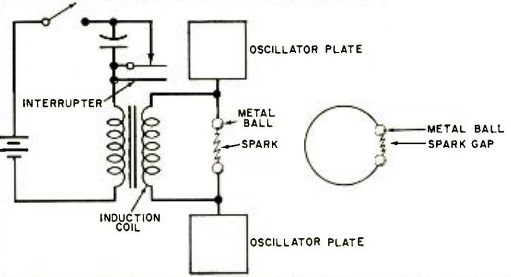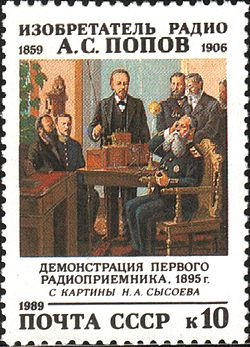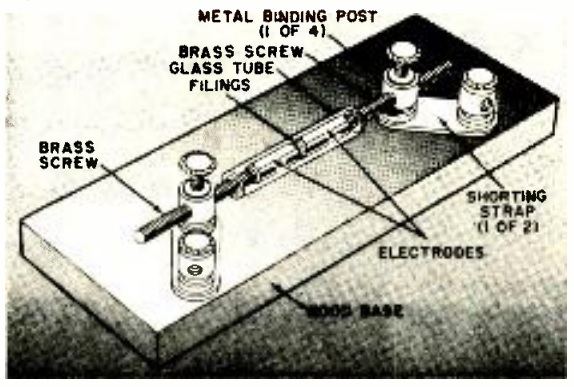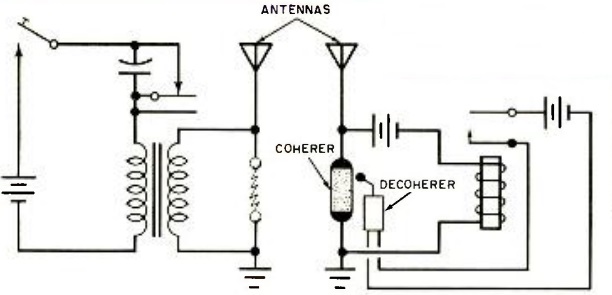Fifty years ago this month, the May 1967 issue of Popular Electronics took a look at the earliest days of radio. In particular, it looked at the coherer, and even showed plans for making the one shown above.
The coherer was one of the first methods of detecting radio waves. In 1850, the French scientist Pierre Guitard had discovered that dust particles in the air cohered, or collected together, when electrified. This principle was later used as a radio detector. Iron filings were placed in a glass tube, and in the presence of a radio wave, they cohered. The presence of the radio wave could be observed directly by looking at the filings. Or, more importantly, the iron filings would provide a current path to operate a bell or other device.
As far as I can tell, the coherer has absolutely no practical value today. Even the most rudimentary crystal detector outperforms it, and has the added advantage of being much simpler to make. But for those interested in experimenting with one of the artifacts of the earliest days of radio, the Popular Electronics article gives enough information to make a working example of the earliest radio detector.
 Electromagnetic fields were first predicted in 1864 by James Clerk Maxwell. It wasn’t until 1887 that this was proven experimentally by Heinrich Hertz, who transmitted a 75 MHz radio signal about 50 feet with the setup shown here. The transmitter consisted of a spark gap not unlike the transmitters used commercially in the early days of radio. The receiver consisted of a loop of wire with an open gap. The radio signal could be observed in the form of a spark in that gap. Hertz discovered that the range could be maximized by adjusting the size of the loop to the wavelength of the transmitted signal.
Electromagnetic fields were first predicted in 1864 by James Clerk Maxwell. It wasn’t until 1887 that this was proven experimentally by Heinrich Hertz, who transmitted a 75 MHz radio signal about 50 feet with the setup shown here. The transmitter consisted of a spark gap not unlike the transmitters used commercially in the early days of radio. The receiver consisted of a loop of wire with an open gap. The radio signal could be observed in the form of a spark in that gap. Hertz discovered that the range could be maximized by adjusting the size of the loop to the wavelength of the transmitted signal.
The next development was the the construction of the first coherer by French physicist Dr. Edouard Branley, which was used by British physicist Sir Oliver Lodge to detect and record Morse code signals sent by a spark transmitter.
After each electromagentic pulse, the coherer had to be decohered manually, since the iron particles remained in place even after the radio signal was gone. Lodge used a “trembler” to decohere the iron filings used in his coherer.

1989 Soviet stamp showing Povov demonstrating first radio, 1895, Wikipedia image.
The coherer was improved considerably by the Russian physicist Aleksandr Stepanovitch Popov. He used the armature of an electric bell to decohere the particles. With this advance, it was possible to receive code at a reasonable speed. When a pulse was received, the particles cohered, which caused the electric bell to sound, which also decohered the particles. If a signal was still present, the process was repeathed. Popov also had the foresight to attach an antenna to the receiver. With the antenna, Popov was able to achieve a range of 900 feet.
Guglielmo Marconi improved the coherer in a number of ways. First, he evacuated the air and replaced the corks at the end with silver plugs. He also replaced the iron filings that had been used previously with a mixture of nickel and silver. Almost immediately, he had increased the range and was receiving signals from 2-9 miles. By 1901, he had increased the range to 200 miles. And on December 12, 1901, he used a coherer to receive signals over 2000 miles from England to Newfoundland.



Pingback: Alexander Stepanovich Popov (1859-1906) | OneTubeRadio.com